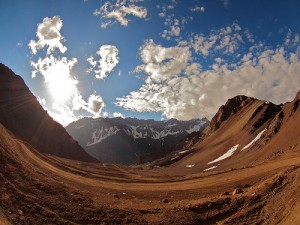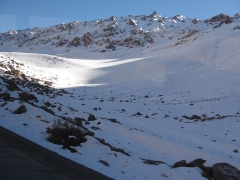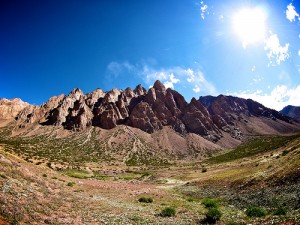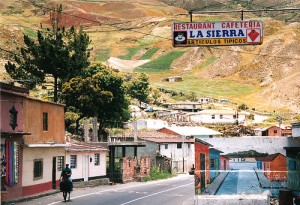 the Travel Enthusiast
the Travel Enthusiast
- 20 Sep
papillon in Fun and Travel | 1 COMMENTHiking & trekking in the Andes: the basics
 Outside of Asia, the Andes are the highest mountain range that you can climb. It’s long, strenuous, cold and utterly amazing. Walking in the footsteps of the Inca and other ancient civilizations is an exhilarating feeling, and you not only get to see some of the most amazing views on earth, but also discover the people and the culture of the small, secluded villages on the trail, and of course, the wildlife. So gather your hiking gear, say your goodbyes to modern life for a while, and say hello to the most epic adventure you can experience in your lifetime.
Outside of Asia, the Andes are the highest mountain range that you can climb. It’s long, strenuous, cold and utterly amazing. Walking in the footsteps of the Inca and other ancient civilizations is an exhilarating feeling, and you not only get to see some of the most amazing views on earth, but also discover the people and the culture of the small, secluded villages on the trail, and of course, the wildlife. So gather your hiking gear, say your goodbyes to modern life for a while, and say hello to the most epic adventure you can experience in your lifetime. First of all, a brief general introduction about the Andes. As you know, the Andes are massive, and the range sprawls over the entire length of South American, for 7000 kilometers, from tip to tail. There are several large plateaus in the Andes, where many major cities are located (Bogota, Santiago de Chile, Sucre, La Paz…), so even if you are visiting one of these cities, you are still in the Andes (but that’s not considered hiking :P).
First of all, a brief general introduction about the Andes. As you know, the Andes are massive, and the range sprawls over the entire length of South American, for 7000 kilometers, from tip to tail. There are several large plateaus in the Andes, where many major cities are located (Bogota, Santiago de Chile, Sucre, La Paz…), so even if you are visiting one of these cities, you are still in the Andes (but that’s not considered hiking :P).The Andes are split into several ranges, and there are countless trails that you can attempt to climb, wherever you are. The highest peak in the Andes is the snowy giant Aconcagua, with a whopping altitude of 6,962 meters. And another fun fact: the peak of Mount Chimborazo, in Ecuador, is the point where the distance to the center of the earth is the largest in the world. There are also many active volcanoes in the Andes, including Cotopaxi, the highest active volcano on the planet. As you can imagine, there is a wealth of ecosystems in the Andes, and the flora and fauna are amazingly rich (if not always dense).
 When in the Andes, there are many outdoor activities that you can undertake, but the most popular remain trekking and hiking. The list of treks and hiking trails in the Andes is so extensive that it’s impossible to mention them all. So what you need to do once you’ve decided to go, is to choose a region.
When in the Andes, there are many outdoor activities that you can undertake, but the most popular remain trekking and hiking. The list of treks and hiking trails in the Andes is so extensive that it’s impossible to mention them all. So what you need to do once you’ve decided to go, is to choose a region.The Southern Andes span over Argentina and Chile, the Central Andes cover the Chilean and Peruvian cordilleras (cordillera means rope in Spanish) and parts of Bolivia, and the Northern Andes include parts of Venezuela, Colombia, and Ecuador (actually, there are two parallel ranges, the Cordillera Occidental and the Cordillera Oriental).
So once you’ve decided which country you are actually visiting, you can take care of visas and other formalities that I won’t talk about here. The most important part of the planning is choosing a tour. Of course, you can plan your hiking/trekking trip on your own as well (the positive side is that you have more freedom when it comes to budget and you can customize
 every aspect of the journey; on the negative side, there is a lot to take care of: accommodation, equipment, taking safety precautions, finding a guide, etc.).
every aspect of the journey; on the negative side, there is a lot to take care of: accommodation, equipment, taking safety precautions, finding a guide, etc.).You also might need to do some research about climate and seasons (and to decide how much cold you are actually willing to withstand). Obviously, some paths become more dangerous come winter, but if you are planning to make a stop at a ski resort or something, you do need a bit of snow.
- Flights
- Hotels
- Packages
- Cars
- Cruises
travel search by Travelgrove (get this widget)
Finally, prepare for some serious exploration. Don’t concentrate only on the physical side of the journey. There will be lots of villages and towns on the way, and while your main priority is to visit the less than populous parts of the Andes, it’s good to stop at human settlements because on one hand you can restock (and send news to family and friends if you are taking a longer journey), and get to know the local culture.You might also like


It is very nice article that you have shared over here.